Robots have been employed in the automobile sector for a long time, and they are still used in various ways today.
FREMONT, CA: Automotive production has historically been one of the first and most aggressive adopters of industrial robotic technology, which continues today. In some form, robots are used in practically every aspect of automotive manufacturing, and the industry continues to have one of the most automated supply chains in the world.
While there are several robotic applications available in the business, there are six that stand out as the most prevalent and valued market.
Robots that Collaborate
Collaborative robots are designed to work with other robots in massive assembly lines. To ensure the efficient operation of such assembly lines, robots must collaborate between handling and welding robots.
Automated Painting
Professional painters are scarce, and the task is exceptionally hazardous. This makes it ideal for robots, as the paint job must be highly consistent across a broad area of paint, and minimizing material loss can add up to significant savings over time.
Automated Welding
For a long time, robotic welding was the leading robotic application in the automotive sector, as each car requires many welds to be completed. Given the finished product's high worth, automation yields significant productivity.
Automated Assembly
Robots assemble minor components such as pumps and motors at rapid speeds in many automotive facilities. Robots are frequently used to execute operations such as windshield installation and tire mounting to boost throughput.
Material Elimination
Robots excel at material removal procedures such as trimming and cutting due to their consistency and reproducibility. This could be in fabric cutting, plastic molding and die casting trimming or even mold polishing.
Part Transfer and Maintenance of Machines
Pouring molten metal, transferring metal stamps, and loading and unloading CNC machines are all dangerous operations best handled by a robot. When carried out consistently and with minimal downtime, they can also be a significant source of productivity.

 Copyright © 2025 AutoTech Outlook. All Rights Reserved | Privacy Policy | Subscribe | Sitemap | About us | Feedback Policy | Editorial Policy
Copyright © 2025 AutoTech Outlook. All Rights Reserved | Privacy Policy | Subscribe | Sitemap | About us | Feedback Policy | Editorial Policy